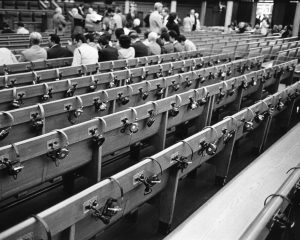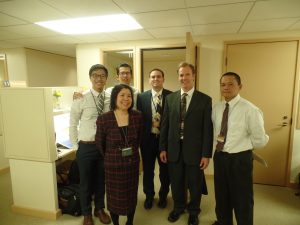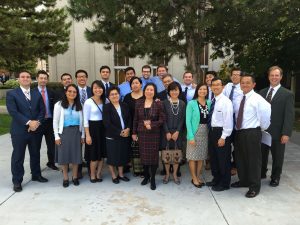
Mauro Properzi was cramped in the basement of the Salt Lake Tabernacle with only a small monitor to help him interpret General Conference from English to Italian in 1997.
Twenty years later, Properzi is now a BYU religion professor, and the Italian interpretation for General Conference is one of 31 other languages interpreted remotely. Another 63 languages are interpreted in their own space of the Church Office Building.
The 187th Semiannual General Conference was translated and interpreted into 94 languages for The Church of Jesus Christ of Latter-day Saints. Teams of interpreters worked in the Church Office Building as well as at interpretation sites in various countries around the world.
About 700 volunteer interpreters handle all the interpretation for General Conference, according to Interpretation Manager Stewart Bridge of the LDS Church’s Publication Services Department.
Over the past six decades, the interpretation process has changed.
Bridge said Spanish and German interpretation was first available in the 1960s. According to Mormon Newsroom, interpretations in Dutch and Samoan began in 1961.
Eventually, the Spanish interpretation of General Conference was broadcast from KSL Radio to a radio station in New York, and from there was broadcasted to Central and South America, according to Bridge.
By the 1970s, demand for General Conference to be interpreted into more languages was increasing, so booths for interpreting about 40 languages were added to the basement of the Salt Lake Tabernacle. These booths included headsets and television monitors the interpreters used to see the speaker.
After construction of the Conference Center completed in 2000, demand for interpretation continued to grow. In 2001 interpreters used 60 languages booths, Bridge said.
Today, each session of General Conference is interpreted into 94 languages. The sessions are interpreted live in 91 different languages and in three additional languages one week after General Conference, according to Bridge.
BYU alumnus Thuan Lynguyen has been a Vietnamese interpreter for General Conference since 2014. Lynguyen said interpreters worked in the Conference Center until 2016, but now work in the Church Office Building because it provides more space for trainings.
Technology has continued to help in the interpretation process of General Conference despite limited space. A “tieline” system now allows many languages to be interpreted on-site and broadcast around the world.
The tieline system sends the English broadcast to a site, where interpreters hear the English through their left ear and then interpret it into their given language. That interpretation is then sent back to Salt Lake City where it is mixed and broadcast worldwide, Bridge said.
This entire process happens in only one second.
With the new tieline system, General Conference is now interpreted in up to 60 languages at the Church Office Building in Salt Lake City. The remainder of the languages are done in-country, Bridge said.
Properzi said he helped at the Italian interpretation site in Rome when he was living there in 2009. Italian interpretation for General Conference is one of the languages now interpreted remotely.
According to Bridge, the best situation is finding native speakers who can interpret General Conference in their own countries. If the language isn’t interpreted remotely, Bridge said the department prefers to find native speakers to help with the translation and interpretation.
However, demand can sometimes require interpreters to be returned missionaries with exceptional language skills and accents.

Lynguyen, a native Vietnamese speaker, said the process to become an interpreter is inspired. During his training, Lynguyen was paired up with an experienced translator in a booth. Then, each took turns interpreting talks from a previous General Conference.
Although he was provided the translated script, Lynguyen said he was nervous about the process.
“I knew how to read Vietnamese. I knew it wasn’t going to be a problem, but it’s a different experience because you have to consider the pacing and the tone of your voice,” Lynguyen said. “That’s what they listen for.”
Usually, the talks are translated before the broadcast and copies of the translation are given to the interpreters to read. However, interpreters have to actively listen because oftentimes speakers make last-minute changes that don’t make it to translation in time, according to Bridge.
Properzi said he once interpreted for Elder David B. Haight, a former member of the Quorum of the Twelve Apostles who didn’t have a prepared talk.
“It was completely impromptu,” Properzi said. “Those become really stressful moments.”
To ease the stress, trainings are held during the year to help the interpreters prepare for General Conference.
BYU student Carliann Moore is currently on the Bulgarian interpretation team. She said all interpreters receive training before each conference, no matter how long they’ve been there.
Moore said the trainings help teach interpreters to listen, pay attention and keep in sync with the speaker.
“(The trainings) train you on how to really put emotion in your voice and to listen to the Spirit,” Lynguyen said.
Interpreters generally receive their assigned talks a week in advance, according to Lynguyen. Depending on the size of each interpretation team, the number of talks a single interpreter is given varies.

Receiving the talks beforehand gives the interpreters opportunities to practice reading their talks so it doesn’t sound monotone or rote, according to Lynguyen.
“Preparation is very crucial for an interpreter,” Lynguyen said. “Even though we are just reading the talk, there is still a lot of preparation that goes into it.”
Properzi said interpreting for conference is an important service because some people wouldn’t have the chance to listen to prophets or apostles without the interpretation.
“We want to make sure that everyone will be able to hear the word of God in their own native language,” Lynguyen said.




